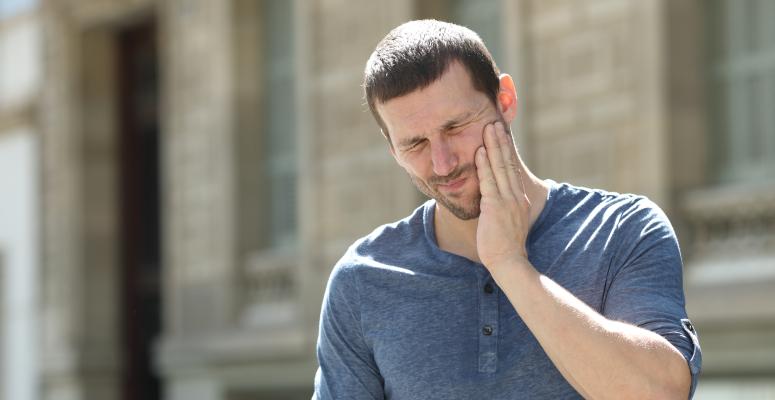
When your jaw hurts, your first instinct is to go to the dentist. While a dentist may be able to diagnose you with a disorder like TMJ dysfunction, physical therapy is one of the best courses of action when you’re trying to alleviate the pain and discomfort.
TMJ dysfunction can be frustrating. Not only does it cause an ache in your jaw, but it can make it difficult to enjoy your food if you’re wincing in pain with every bite. The good news is that there is a common physical therapy technique that uses small needles to help reduce your TMJ dysfunction pain, called dry needling.
Keep reading to learn about TMJ dysfunction and dry needling. We’ll also discuss the benefits of trying the physical therapy technique to help reduce TMJ disorder symptoms.
The basics of TMJ dysfunction
TMJ dysfunction, often referred to as TMJ disorders (TMDs), refers to conditions that cause pain in the temporomandibular joint (TMJ) as well as the surrounding ligaments and muscles. This joint works as a sliding hinge that connects your skull to your jawbone.
The pain from TMJ dysfunction normally flares up in your jaw joint and chewing muscles. The ache can even spread to your face and down to your neck. TMJ dysfunction pain is often coupled with other symptoms including:
- Jaw stiffness.
- Feeling like your jaw is locking up.
- Grating or clicking sounds when you open and close your mouth.
- Dizziness.
- Ringing in the ears.
If you’re experiencing these symptoms, you’re not alone. TMJ dysfunction is a common condition, as it has a 31% prevalence rate among adult and elderly populations.
The basics of dry needling
Dry needling is a physical therapy technique that uses thin monofilament needles to alleviate pain that’s stemming from your muscles or “trigger points.” The needles are inserted into the skin, either into the trigger point or the surrounding area, to stimulate the affected muscles. The needles cause them to contract and release the painful tension. The technique can also accelerate the healing process by increasing blood flow to the area.
When the surrounding nerves are stimulated, your brain can release endorphins, which are hormones that can help reduce pain.
5 reasons why you should consider dry needling for TMJ dysfunction
Dry needling can be used to treat pain all over the body, including in your jaw. Dry needling can help alleviate your TMJ dysfunction pain as well as increase your jaw’s mobility to allow you to comfortably move your jaw.
Here are five reasons why dry needling for TMJ dysfunction is worth considering:
- Improved jaw function — The main benefit of using dry needling to treat TMJ disorder is improved function of your jaw. By reducing your pain and increasing mobility of the temporomandibular joint, you can comfortably complete actions that require opening wide, such as eating or yawning.
- Minimal discomfort afterward — While some treatment options that use additional tools may cause side effects, dry needling for TMJ dysfunction has little to no lingering effects. While it’s possible to feel muscle soreness for up to 48 hours, only about 3% of dry needling patients feel pain afterward.
- Reduced TMJ headaches — The pain from TMJ dysfunction can spread throughout your face, potentially causing headaches. The good news is that chronic headaches can also be treated with dry needling, so you can alleviate two areas of pain with the same technique. Your therapist can help determine if TMJ dysfunction is the main source of your headache or if it requires additional needles placed around the head.
- Immediate results — Even though you will have to go back to the physical therapy clinic for multiple sessions to treat TMJ dysfunction symptoms, you will likely have quick relief from your pain and jaw stiffness after each one. Many patients experience increased mobility immediately following a dry needling session.
- Short sessions — Many people have a packed schedule, and don’t often have the flexibility in their day for long appointments. But dry needling sessions usually only take 20 minutes or less, so it’s easy to work into your calendar without disrupting other responsibilities.
Find effective and affordable care for dry needling for TMJ dysfunction from an Alliance PTP partner
Even though TMJ dysfunction can be painful, there are many benefits of treating it with dry needling. That’s why you should discuss the pain management option with a physical therapist.
Physical therapy can be an effective and affordable way to care for your TMJ dysfunction with dry needling. You just need the right partner to provide it.
Alliance Physical Therapy Partners has you covered. We can help you find a PT clinic near you that’s staffed with experienced and caring physical therapists.
Reach out to us today so we can help you find the physical therapy clinic that works best for your needs.
Get Help at a Location Near You
